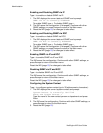
NetEngine IAD User Guide
Administration 27
RADIUS
Server
Settings
You can use a RADIUS server to determine the validity of unknown user
ID/password pairs in your IAD. To use a RADIUS server, set the following
options:
Change the primary or secondary RADIUS Server Address
Change the primary or secondary RADIUS Encryption Secret
Display RADIUS Configuration
If you configure a RADIUS server, the IAD must be able to successfully
connect to the RADIUS Server. This requires WAN configuration, IP
configuration, static or default routes and other configurations for your
network. Additionally, you must use a RADIUS-authenticated user ID/
password for Telnet access. If the RADIUS server becomes inoperative,
Telnet access will not work.
Changing the RADIUS Server Address
To change the primary or secondary RADIUS server address:
1. On the Main menu, type 8 (Configure Login) to display the Password
Configuration menu (page 25).
2. Type 5 to select Change Primary RADIUS Server Address or Type 7
to select Change Secondary RADIUS Server Address.
The IAD displays the following message:
Primary/Secondary RADIUS Server is currently:
Enter new Primary/Secondary RADIUS Server as either
an IP address or name >
3. Type the IP address in one of the following formats and press Enter:
IP address
Fully-qualified host and domain names
(for example: radius.Verilink.com—maximum 42 bytes)
4. Reset the IAD (page 15).
Changing the RADIUS Encryption Secret
To change the primary or secondary RADIUS encryption key:
1. On the Main menu, type 8 (Configure Login) to display the Password
Configuration menu (page 25).
2. Type 6 to select Change Primary RADIUS Encryption Secret or type 8
to change Secondary RADIUS Encryption Secret.
The IAD displays the following message:
Primary/Secondary RADIUS Encryption Secret is
currently:
Enter new Primary/Secondary RADIUS Encryption Secret
NOTE
Verilink does not provide a RADIUS server. You must provide
a RADIUS server to use this feature. For more information on
RADIUS servers, see RFC 2865.
NOTE
If you enter host and domain names, you must configure the
IAD as a DNS client (page 114).


















